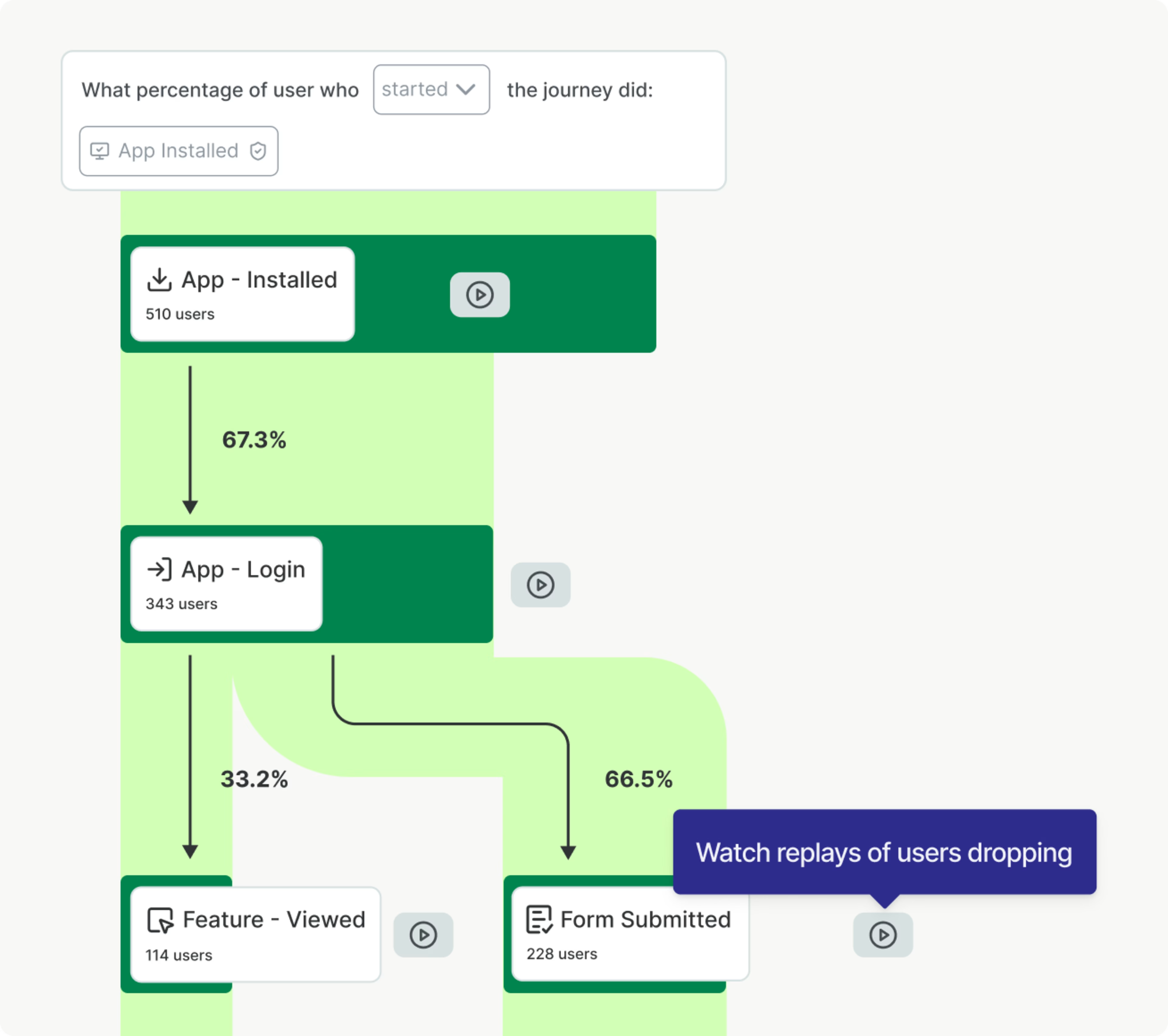It’s no secret that a seamless digital customer experience (CX) leads to greater growth. But when data is fragmented and ownership between teams is unclear, it can be difficult to know whether you’re truly meeting customer expectations across touchpoints.
A regular digital analytics audit can change that. Besides proving which strategies actually work, this key process reveals your blind spots and broken funnels so you can optimize and deliver experiences that match your customers’ needs.
In this chapter, we outline 6 crucial steps for auditing your digital analytics—plus the tools and tactics that help you make it actionable, shareable, and repeatable.
Key insights
Use AI-powered digital analytics to turn your audits into a strategic advantage by uncovering patterns, predicting user behavior (like churn), and detecting anomalies
Auditing your digital portfolio is a team sport—with marketing, product, user experience (UX), conversion rate optimization (CRO), and ecommerce teams sharing ownership of key performance indicators (KPIs) and end-to-end user journeys
Document your audits—not only to help with current alignment but promote consistency and empower your teams to conduct successful audits in the future
6 steps to a well-executed digital analytics audit
A digital analytics audit is a comprehensive review of your tools, tracking setup, and multichannel strategies across the user journey, from acquisition to retention.
Audit these areas, at least quarterly, to:
Understand users throughout your entire digital portfolio: from website and apps to support channels, social media, and marketing campaigns
Align with other teams on common metrics to achieve shared goals
Surface deeper, actionable insights that guide strategy and implementation
Lay the groundwork for a UX audit or CRO audit, so you can prioritize and optimize for maximum business impact
Below, we break down the auditing process into a simple, user-friendly format, enabling anyone on your team to carry out the audit successfully.
Step 1: define your objectives
To set clear and measurable objectives, look through the lens of your business goals and metrics.
What are you and your team trying to accomplish this quarter or year? Maybe it’s increasing monthly recurring revenue, improving checkout conversion, or understanding which content resonates most with enterprise users. Whatever it is, you need to be able to tie it back to your company’s goals.
Now ask: are your team objectives aligned with your current digital strategy? If not, it’s time to define the metrics and KPIs that matter, which, in turn, will reshape your digital analytics strategy.
Step 2: analyze performance and identify gaps
Break down your digital efforts by channel to uncover what’s working, what’s not—and why. Focus on quantitative metrics first to know what’s happening. You can pull this data from platforms like Google Analytics, Contentsquare’s Product Analytics (powered by Heap), and Meta Business Suite.
Here’s how you can analyze
Web pages: are users finding what they need or bouncing quickly?
Product features: are they completing tasks or getting stuck mid-journey?
Email campaigns: which messages drive engagement or traffic that converts?
Paid ads: are certain campaigns attracting low-quality traffic?
Social media: do visitors from this channel explore or exit right away?

Use Product Analytics to investigate and optimize user journeys within your app
Meanwhile, qualitative data reveals the why behind the what. You can collect qualitative insights with a usability testing audit, social listening, and voice-of-customer (VoC) tools. VoC insights from surveys, feedback forms, and user interviews offer real-world context to back up hard numbers like bounce rate and conversion rate.

Launch surveys to contextualize exits from high-impact pages
Together, quantitative and qualitative data paint a complete picture of user behavior, and channel and campaign performance. You can then assess the strengths and weaknesses of each channel. To spot red flags, watch for channels driving high traffic but low conversion, increased bounce and exit rates, and poor retention or no repeat visits.
Analyze and double down on what works while addressing or reducing investment into what doesn’t.
Pay attention to both types of data—qualitative and quantitative. A lot of clients will spend a lot of time in a voice of customer or traditional analytics tool but the merging of both of those data types really gives you the full, well-rounded picture and can really help you optimize.
Step 3: validate data accuracy
Ensure you’re working with accurate, reliable data. Quality data sharpens your analysis, allowing you to make smarter decisions and take more impactful actions. Each user-centric improvement builds toward a consistently delightful CX.
Start with these 3 questions to set the right data foundation:
Are you tracking events correctly? Catch issues such as double tracking, misfiring, and missing events due to implementation errors or script conflicts.
Are you tracking key user actions? Identify gaps that might prevent you from capturing critical moments across your omnichannel campaigns.
Is data sampling skewing your reports? Check whether your digital analytics tools have a sampling limit—if you’ve exceeded that limit, you might miss valuable user behavior data.
💡 Pro tip: leverage Contentsquare’s tracking set-up assistant for websites and logging capabilities for apps to validate event tracking, even early in the development phase. While your engineers handle that, non-technical team members can flag issues when they notice data inconsistencies.
Step 4: evaluate your tech stack
Look at the tools you’re using to track your digital analytics metrics from Step 2. Evaluate whether they’re still serving your needs or merely duplicating your efforts. Do they provide full coverage of key pages, journeys, and funnels? Are you using all of them enough to justify the cost and complexity?
If not, maybe it’s time to streamline. This is where Contentsquare’s all-in-one experience intelligence platform comes in. It eliminates the need for multiple overlapping tools by capturing performance and user behavior across the entire digital journey.
You can run audits with the platform’s Product Analytics and Experience Analytics products and dive into conversion journeys, frustration areas, and feature usage. Use the Heatmaps capability to visualize user engagement, and then jump into Session Replay to uncover why they stay on or leave the page. Collect customer insights with user tests or interviews to validate hypotheses, test new features or messaging, and identify unmet needs in specific journeys.
At the same time, Contentsquare enables constant, always-on monitoring so you can implement mini audits. Use the platform’s Experience Monitoring product with AI-powered alerts to spot patterns, trends, and shifts in user behavior, so you can surface and fix issues fast.
Launch VoC tools such as on-site surveys to gather targeted feedback on usability, content relevance, or feature usefulness, helping you make informed decisions and prioritize improvements.
![[Visual]heatmaps for website optimization](http://images.ctfassets.net/gwbpo1m641r7/1CBe7tMqN7DAaWcggfpQpY/bf922ad649a64deebc58c0d97ceccbbf/eyJwYXRoIjoiY29udGVudHNxdWFyZVwvZmlsZVwvNk5jVHZ5NWZOeG8yQ2NiQ0c3R0QucG5nIn0_contentsquare_bPtyc4-qnyK-oonEzdZGw1OMTXCO9SraLr.png?w=3840&q=100&fit=fill&fm=avif)
You can jump from heatmaps to related session replays to uncover user behavior in Contentsquare
💡 Pro tip: with Contentsquare’s Data Connect capability, you can bring behavioral, performance, and error data directly into your warehouse of choice. Seamlessly combine insights—no manual effort needed—with other data sources, including AI and machine learning models. With faster time to insight, you can optimize journeys, predict churn, and personalize experiences more effectively than your competitors.
Step 5: review security and privacy
One more thing about tools…
Before adding any to your tech stack, make sure it meets users’ expectations of data protection and privacy. Every website, app, and product tracking tool should comply with relevant acts and regulations, such as the General Data Protection Regulation (GDPR) and the California Consumer Privacy Act (CCPA).
A core part of compliance is also checking for operational basics, such as cookie and consent management and up-to-date access permissions.
At Contentsquare, privacy is built-in: this protection layer applies to all platform users and their end-users. In practice, this means Contentsquare
Is GDPR- and CCPA-compliant
Holds ISO 27701 and ISO 27001 certifications
Enables users to request and delete their data at any time
Follows strict data minimization principles, collecting only what’s necessary to deliver digital analytics services
Use the same criteria to evaluate any of your analytics solutions.
Step 6: recommend and act on improvements
A digital strategy audit isn’t complete without recommending and driving action.
You should now have a clear idea of the metrics, tracking setup, and tools you need to maximize resources and refine your strategies. It’s time to document your findings and report on your digital analytics performance so you can get buy-in from your collaborators, stakeholders, and company leaders.
Insight-driven collaboration is one of the emerging digital analytics trends of today and won’t be going away in the near-future. Use Contentsquare to build digital analytics dashboards and access powerful visual insights—from tools like heatmaps and session recordings—to effectively convey takeaways, overcome objections, and get support for executing your next-level strategy to transform digital CX.
Act on insights and optimize your digital strategy
Conducting a digital analytics audit is a surefire way to align your marketing, UX, CRO, and product strategies with your users’ real needs. As such, it never really stops. You can schedule it 2 to 4 times a year—or more frequently, such as after campaign launches, new feature releases, or a website redesign.
This 6-step audit guide gives you a repeatable, user-friendly framework to make sense of your digital portfolio and CX, helping you turn insight into action.
![[Visual] Digital analytics audit](http://images.ctfassets.net/gwbpo1m641r7/2El3YuZBTZ3ltpF9qBv0zR/51f43fc489bb72e00a83912902a982d9/AdobeStock_545543268.jpeg?w=3840&q=100&fit=fill&fm=avif)
![[Visual] Contentsquare's Content Team](http://images.ctfassets.net/gwbpo1m641r7/3IVEUbRzFIoC9mf5EJ2qHY/f25ccd2131dfd63f5c63b5b92cc4ba20/Copy_of_Copy_of_BLOG-icp-8117438.jpeg?w=1920&q=100&fit=fill&fm=avif)
![[Visual] stock photo voc](http://images.ctfassets.net/gwbpo1m641r7/6Wailldy58FtpuPdcqjw9V/a06e2f3beae3f2ba5a816cff8cdedad4/The_Humans_Strike_back.png?w=1920&q=100&fit=fill&fm=avif)
